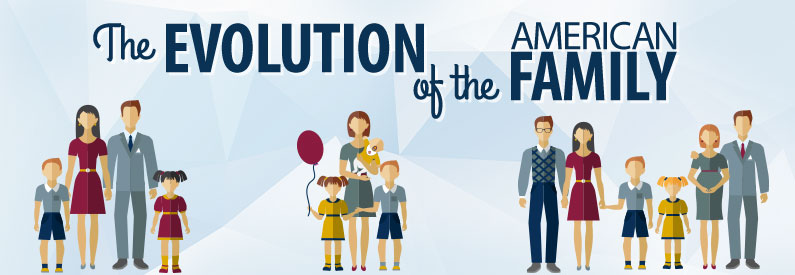#family #culture
“In the main, America’s culture evolves to reflect the predominant values of the day, including social systems such as the family” — Paul Ebeling
Instead of being 1 unit, the family institution has been in a constant state of evolution. Today, there really is no consistent definition of the American family. With single-parent households, varying family structures, and fewer children, the modern family defies categorization.
And these changes have brought with them the myth that divorce, domestic violence, and single parenthood are recent phenomena. When the history of the American family was surveyed in-depth it became apparent that this is not the case.
Constant change and adaptation are the only themes that remain consistent for families throughout America’s history. In fact, recent changes in family life are only the latest in a series of transformations in family roles, functions, and dynamics that have occurred over time.
When America was founded, a family was defined as a husband, wife, biological children and extended family, no slaves included. Meaning that most people who could legally marry did, and then stayed married until death.
In the 19th and early 20th Centuries people often married to gain property rights or to move social class. All of that changed in the 1800s, with the ideas of love and romance becoming the main reason to wed.
Divorce was rare; “the process of getting a divorce was very expensive, and a judge would never allow it, unless it was the last resort.
So, 2 people were unhappy in a marriage, they sometimes decided to quietly separate in a mature, responsible way, but they were legally still married, and could never remarry someone else, unless their 1st husband or wife died.
Because this structure was so dominant, it played a Key role in the creation and replication of cultural roles for men and women. The role of wives was to assist their husbands within the home, both keeping house and raising children.
It was generally against the law to live together or have children outside of marriage. However, by the 19th Century, coverture was less of an issue and these rigid legal boundaries were relaxed, with common-law marriage widely recognized as an acceptable union.
New ideas about marriage emerged, based on choice, companionship, and romantic love. This in turn caused a surge in the divorce rate, which 3X’d between Ys 1860 and 1910.
The stability of families was tested by the Great Depression, as unemployment and lower wages forced Americans to delay marriage and having children. The divorce rate fell during this time because it was expensive and few could afford it.
And by Y 1940 almost 2-M married couples lived apart. Some families adjusted to the economic downturn by returning to a cooperative family economy. Many children took part-time jobs and many wives supplemented the family income.
When the Depression ended and World War II began, families coped with new issues: a shortage of housing, lack of schools and prolonged separation. Women ran households and raised children alone, and some went to work in war industries. The results of the war-stricken state of society were that thousands of young people became latchkey children and rates of juvenile delinquency, unwed pregnancy, and truancy all rose.
In reaction to that turmoil both at home and abroad during the 1940s, the 1950s marked a swift shift to a new type of domesticity.
The idea of the nuclear, All-American Family was created in the 1950s, and put an emphasis on the family unit and marriage. This time period saw younger marriages, more kids, and fewer divorces. The average age for women to marry was 20, divorce rates stabilized, and the birth rate 2X’d. However, the perfect images of family life that appeared on television do not tell the whole story, as 60% of children spent their childhood in a male-breadwinner, female-homemaker household.
How I and the majority of my friends grew up…
The standard structure of the family in postwar America consisted of a breadwinner male, his wife who did household chores and looked after the children, and the children themselves.
Families ate meals and went on outings together, and lived in sociable neighborhoods. Parents paid close attention to disciplining their children and live-in relationships were unheard of.
In fact, girls stayed in their parents’ home until marriage and did not commonly attend college. Children became emotional rather than economic assets for the 1st time, close with their parents and the center of the family.
Because of this, parents studied child development and worked to socialize their children so that they would become successful adults. Childhood became a distinct period of life. And, young girls were supposed to be housewives instead of educated professionals.
All in all, family structure in the 1950s was based around one central necessity: a secure life. As the economic and global instability of the early 20th Century gave rise to the need for closely defined family units. This led to an ideology that lauded economic advancement and social order, the results of which were younger marriages that lasted longer, more children, fewer divorces, and more nuclear families.
The modern family bears little resemblance to this ideal unit.
Many of the changes that were part of this transition are a direct result of the expanding role of women in society, both in terms of the workplace and education.
The rise of the post-industrial economy, based in information and services, led to more married women entering the workplace. As early as Y 1960, 33% of middle class women were working either part-time or full-time jobs. Since the 1960s, families have also become smaller, less stable, and more diverse.
Today, the male-breadwinner, female-housewife family represents only a small percentage of American households. As a majority, 62%, of Americans view the idea of marriage as a unit in which husband and wife both work and share child care and household duties. Such 2-earner families are much more common too.
In Y 2008, the US Bureau of Labor Statistics reported that women made up almost 50% of the paid labor force, putting them on equal footing with men when it comes to working outside the home. In addition, single-parent families headed by mothers, families formed through remarriage, and empty-nest families have all become part of the norm.
Along with these shifts have come declining marriage and birth rates and a rising divorce rate.
The American birth rate is half of what it was in 1960, and hit its lowest point ever in Y 2012. In addition, the number of cohabiting couples increased from less than 500,000 in Y 1960 to 4.9-M in the Y 2000 census. And according to the Y 2005 American Community Survey, more than 50% of households in America were headed by an unmarried person during that year. And by Y 2007, almost 40% of children were born to unmarried, adult mothers. One reason for these developments is that marriage has been repositioned as a cornerstone to capstone, from a foundational act of early adulthood to a crowning event of later adulthood. It is viewed as an event that should happen after finishing college and establishing a career.
Many who are interested in family development and culture choose to pursue a career in family science. With an emphasis on current issues and skills for living successfully in today’s society, this applied science is constantly evolving, much like the family units that are its area of study. It is a discipline including contributions from related academic areas such as law, sociology, psychology, anthropology, healthcare, and more.
Because of this, professionals in the field practice in a variety of contexts, including:
- Education
- Research
- Community outreach
- Human services
- Nutrition
The field of family science plays an important role in navigating the implications of today’s global society. Though the families of today have little in common with those in previous decades and centuries, family science professionals have a clear perspective on how to approach the complexities of a constantly evolving institution. These skills will only become more valuable as families continue to evolve.
Have a happy, healthy New Year, Keep the Faith!









